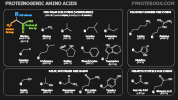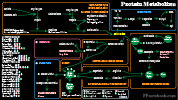II. Definitions
- Amino Acids
- Twenty common Amino Acids occur in humans, in which 9 are essential (must be ingested)
- Peptides
- Short chains of Amino Acids (two or more)
- Proteins (polypeptides)
- Long chains of peptides (which in turn are chains of Amino Acids)
III. Physiology: Structure
- Primary Protein Structure
- Specific Amino Acid sequence defining a Protein
- Secondary Protein Structure
- Regular local structure of the Protein
- Common secondary structures include alpha-helix (right-handed spiral) and beta strand (straight segment)
- Tertiary Protein Structure
- Overall spatial arrangement of a Protein (globular, membane, fibrous)
- Globular Proteins (spherical) include Hemoglobin, albumin and most enzymes
- Fibrous Proteins with straight chains include structural Proteins (e.g. Collagen, elastin, Fibrinogen)
- Quaternary Protein Structure
- Assembly of multiple Proteins combined (e.g. interwoven Collagen fibers)
IV. Physiology: Function
- Functioning Protein (Holoprotein) is composed of two components
- Apoprotein
- Active Protein without Cofactors (e.g. globin in Hemoglobin)
- Apoenzyme refers to the Apoproteins of enzymes
- Apolipoprotein refers to Apoproteins of Lipoproteins (e.g. HDL, LDL)
- Prosthetic Group
- Non-Protein Cofactor (e.g. heme in Hemoglobin)
- Coenzymes refers to the prosthetic groups of enzymes
- Apoprotein
- Zymogen
- Inactive precursor to an active enzyme
- Activated by a metabolic pathway that modifies the Zymogen (e.g. cleavage, phosphorylation)
- Examples
- Gastrointestinal Metabolism (e.g. Trypsinogen to trypsin, Pepsinogen to Pepsin)
- Clotting Pathway (e.g. Prothrombin to Thrombin, Fibrinogen to Fibrin)
V. Physiology: Essential and Non-Essential Amino Acids
- Essential Amino Acids are generated by complex biosynthetic pathways not available in humans
- Histidine
- Isoleucine
- Leucine
- Lysine
- Methionine
- Phenylalanine
- Threonine
- Tryptophan
- Valine
- Conditional Essential Amino Acids are deficient in early childhood and at times of physical stress
- Arginine
- Cysteine
- Glutamine
- Tyrosine
- Glycine
- Ornithine
- Proline
- Serine
- Nonessential Amino Acids
- Includes the 8 conditional essential acids (except at times of physical stress)
- Alanine
- Aspartate
- Glutamate
VI. Physiology: Amino Acid Polarity by R-Group
-

- Non-polar side chains (hydrophobic)
- Glycine
- Alanine
- Valine
- Leucine
- Isoleucine
- Cysteine
- Methionine
- Proline
- Phenylalanine
- Tryptophan
- Polar uncharged side chains
- Serine
- Threonine
- Asparagine
- Glutamine
- Tyrosine
- Positively charged side chains
- Lysine
- Arginine
- Histidine
- Negatively charged side chains
- Aspartic Acid
- Glutamic Acid
VII. Physiology: Amino Acid Structures by R-Group
- Background
- Amino Acids vary by their R group
- Amino Acids share 3 common bindings to a core carbon
- Amino group or NH3 (in Proteins, binds to the COOH on the prior Amino Acid on the left)
- Hydrogen
- COOH (in Proteins, binds to the NH3 on the next Amino Acid on the right)
- Aliphatic R Group (open carbon chains)
- Glycine
- Alanine
- Valine
- Leucine
- Isoleucine
- Aromatic R Group (benzene ring)
- Tyrosine (also contains a hydroxyl group)
- Phenylalanine
- Tryptophan
- Hydroxyl Containing R Group
- Serine
- Threonine
- Sulfur Containing R Group
- Cysteine
- Methionine
- Carbonyl Containing R Group (C=O)
- Aspartate
- Asparagine
- Glutamate
- Glutamine
- Alkaline R Group
- Arginine
- Lysine
- Histidine
- Imino Acid
- Proline
VIII. Physiology: Protein Metabolism
-

- See Protein Metabolism
- Non-Essential Amino Acid Synthesis (via Kreb Cycle or from other Amino Acids)
- Aspartate is synthesized from oxaloacetate
- Asparagine is synthesized from Aspartate
- Glutamate is synthesized from alpha-ketoglutarate
- Glutamine and Proline are synthesized from Glutamate
- Glycine and Cysteine are synthesized from Serine
- Tyrosine is synthesized from Phenylalanine
- Aspartate is synthesized from oxaloacetate
- Synthesis of other molecules from Amino Acids
- Nucleic Acids (DNA, RNA)
- Ribose 5-P backbone is synthesized from Glucose-6P or Glyceraldehyde
- Purines (ATP and GTP) are synthesized from Aspartate, Glutamine and Glycine
- Pyrimidines (TTP, CTP and UTP) are synthesized from Aspartate and Glutamine
- Sphingolipids (e.g. Sphingomyelin, Cerebroside, Ganglioside)
- Serine acts as a backbone for Fatty Acid attachment (similar to Glycerol in Triglycerides)
- Hormonal synthesis
- Histidine is converted to Histamine
- Tyrosine is converted to Thyroxine,Triiodothyronine, Melanin, Norepinephrine, Dopamine and Epinephrine
- Tryptophan is converted to Serotonin and Melatonin
- Nucleic Acids (DNA, RNA)
- Catabolism: Protein as Fuel
- Protein yields 4 kcals/g with catabolism
- Protein is the last to be catabolized in starvation (after Carbohydrate and fat)
- Proteins are broken down to Amino Acids and some small peptides before absorption
- See Gastrointestinal Metabolism
- Mediated by Stomach acid, pepsin, trypsin and peptidases
- Amino Acids are broken down into ammonia (NH3) and a carbon skeleton
- Ammonia is excreted as urea (via urea cycle)
- 2-Ketoglutarate mediated transamination removes NH3, and forms Glutamate
- Glutamate mediated oxidative deamination releases NH3 and forms 2-Ketoglutarate
- Glutamate (and asparate) donate NH3 for various synthesis (e.g. Purines, Pyrimidines)
- Ammonia enters urea cycle as carbamoyl phosphate and is ultimately excreted as urea
- Urea cycle primarily occurs in the liver
- Carbon skeleton is further processed
- Kreb Cycle (glucogenic Amino Acids)
- Acetyl CoA and Acetoacetate (ketogenic Amino Acids)
- Ammonia is excreted as urea (via urea cycle)
- Most Amino Acids are glucogenic (may generate Glucose via Gluconeogenesis)
- Exceptions: Two Amino Acids are only ketogenic (metabolized to acetyl CoA and Acetoacetate)
- Lysine
- Leucine
- Some Amino Acids are both glucogenic and ketogenic
- Isoleucine
- Tyrosine
- Phenylalanine
- Tryptophan
- Threonine
- Exceptions: Two Amino Acids are only ketogenic (metabolized to acetyl CoA and Acetoacetate)
- Amino Acids enter the Kreb Cycle at various points (for energy generation)
- Pyruvate
- Glycine
- Alanine
- Tryptophan
- Serine
- Threonine
- Cysteine
- Acetyl CoA (Ketogenic Amino Acids)
- Lysine
- Leucine
- Isoleucine
- Tyrosine
- Phenylalanine
- Tryptophan
- Threonine
- Alpha Ketoglutarate (2-Ketoglutarate)
- Proline
- Glutamate
- Glutamine
- Arginine
- Histidine
- Succinate
- Valine
- Isoleucine
- Threonine
- Methionine
- Fumarate
- Tyrosine
- Phenylalanine
- Aspartate
- Oxaloacetate
- Aspartate
- Asparagine
- Pyruvate
IX. Physiology: Protein Function
- Transport and storage Proteins
- Hemoglobin And Myoglobin (oxygen transport)
- Transferrin and Ferritin (iron transport and storage respectively)
- Thyroglobulin (Thyroxine)
- Albumin (binds many molecules in plasma)
- Structural Proteins
- Collagen (cartilage, bone, connective tissue)
- Elastin (connective tissue elasticity)
- Keratin (nails, hair)
- Motion
- Myosin and actin (Muscle)
- Tubulin (cilia, flagellae)
- Hormones
- Enzymes
- Nearly all cellular metabolic processes are catalyzed by enzymes
- Miscellaneous
- Transcription factors (regulate gene expression)
- Antibody
- Clotting Factors
- Growth Factors
X. References
- Goldberg (2001) Clinical Biochemistry, Medmaster, Miami, p. 24-9
